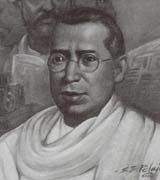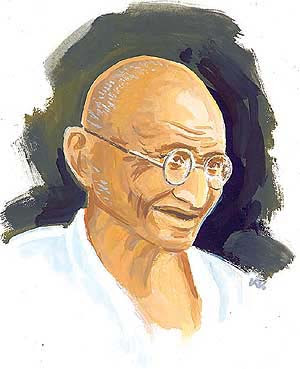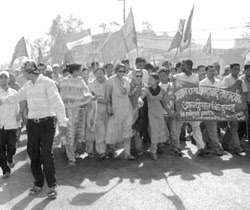
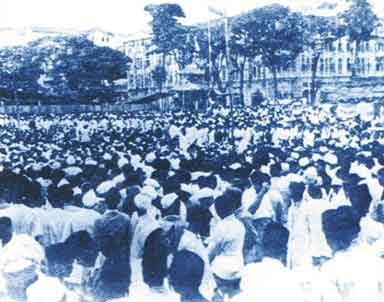
The Quit India Movement (Bharat Chhodo Andolan or the August Movement) was a civil disobedience movement launched in India in August 1942 in response to Mohandas Gandhi's call for immediate independence. Gandhi hoped to bring the British government to the negotiating table.[1] Almost the entire Congress leadership, and not merely at the national level, was put into confinement less than twenty-four hours after Gandhi's speech, and the greater number of the Congress leaders were to spend the rest of the war in jail.
Under the leadership of Gandhi the Quit India Movement was launched. The purpose of this was to set up series of non-violent ways hopefully leading up to the long awaited Independence. From this quote by Gandhi "We shall either free India or die in the attempt; We shall not live to see the perpetuation of our slavery" the saying Do or Die soon became popular among the Indian people. This was a simple way of stating the way the importance to regain independence.
This Movement got off to a rocky start because before Congress could pass the movement the government declared it illegal and arrested all of the major leader. As a result of this a series of revolts broke out in what was known as "British Quit India." The middle class was especially active during the first few phases. But they were soon weakened by the harsh repression. The last phase in the movement was a difficult one characterized by terrorist activity against communication, police and army installations.
A man named Chandrashekhar Azad put together a campaign called Azad Hind Fauj which stood for Indian Nations Army-INA. His only slogan during the whole campaign was simply "Give me blood and I'll give you freedom."
Many people of India joined in the INA to support the Indian soldiers. But sadly enough after the the Japanese defeated them in 1945 they INA's power and strength slowly declined from there. This was significiant because India as a whole supported the INA with all there strength because they were the people standing up and protecting them. And one time when there was a military tribunal held against several INA officers and they were found guilty to severe punishment, the people of India became enraged. As a result of this the Government cancelled their punishment.
The Government was strongly against the movement and their goal was to make sure it didn't get out of hand. They did everything from arrested people to physically beating others. The supports of the movement were often shot at and sometimes every bombes from the sky. This was definitly one of the most brutal events to happen in India. The British people definitly came out on top and the remaining two and a half years remained unchanged politically wise until the day their independence was granted to them.
Saturday, March 22, 2008
The Quit India Movement
Saturday, March 15, 2008
Lal Bahadur Shastri
 Lal Bahadur Shastri (1904-66)
Lal Bahadur Shastri (1904-66)Now mostly forgotten, Lal Bahadur Shastri was a man of vision and of supreme patriotism. A generous man, he gave away all of his wealth and became advocate of land reform through land donations (Bhudaan). A devout Gandhian, he advocated social reform as a means to achieve self-reliance.
Lal Bahadur Shatri went on to become the second Prime-minister of India after the death of Jawaralal Nehru. He died under mysterious circumstances on a peace mission to Soviet Union. He was a popular leader of the Indian National Congress and gave the country the slogan "Jai Jawan- Jai Kisan" (Hail the Soldier, Hail the Farmer)
Bipin Chandra Pal
Teacher, journalist, writer and librarian, Bipin Chandra Pal started as a supporter of Brahmo Samaj, turned to Vedanta and ended up as an upholder of the Vaishnava philosophy of Sri Chaitanya. He was ardent social reformer-he married a widow of a higher caste twice in his life and gave his powerful support to the Age of Consent Bill of 1891. He wrote a series of studies on the makers of modern India such as Raja Ram Mohan Roy, Keshab Chandra Sen, Sri Aurobindo Ghosh, Rabindranath Tagore, Ashutosh Mukerjee and Annie Besant. He preached a "composite patriotism" that implied a universal outlook.
"Paridarsak" (1886-Bengali weekly), "New India: (1902-English weekly) and "Bande Mataram" (1906-Bengali daily) are some of the journals started by him.
Born on November 7, 1858, in a village in Sylhet (now Banglagdesh), of well-to-do parents, Pal had to cut short his education at the Intermediate stage. He came under the influence of eminent Bengali leaders of his time such as Keshab Chandra Sen and Pandit Sivanath Sastri. He was imprisoned for six months on the grounds of his refusal to give evidence against Sri Aurobindo in the Bande Mataram sedition case. He visited England (three times) and America.
Pal opposed Gandhiji's non-cooperation Movement of 1920. The first Congress session he attended was in 1886 as a delegate from Sylhet.
Pal virtually retired from politics from 1920 though he expressed his views on national questions till his death on May 20, 1932.
Friday, March 14, 2008
Lokamanya Bal Gangadhar Tilak (1856-1920)
"Swaraj is my birthright and I shall have it!" were the fiery words of Tilak which roused a sleeping nation to action, making Indian people aware of their political plight under a foreign rule. Tilak did not question the British Sovereignty nor his demands rebellious or revolutionary. All he was asking was favorable conditions in India, to enable people to learn to govern themselves. May be all over the world, the separatist forces should follow his vision and define freedom as ability to govern one's land. But the handful rulers who ruled India's millions thought otherwise. They thought that Tilak was whipping a rebellion and he was imprisoned twice; two years for the first and six during the second. They said, he had committed treason.
Lokamanya
Bal Gangadhar Tilak
(1856-1920)
Born in Ratnagiri, a small coastal town in 1856 in a middle class family, Tilak had to fend himself for college education. At an early age he was convinced that the educational system the British provided for the Indians was not at all adequate. After graduation and a law degree, he helped found a school which laid emphasis on nationalism. He started a news paper 'Kesari' which tried to teach Indians of their glorious past and reminded them to be self reliant (Swadeshi).
The British used all the native raw materials to run their factories in England and sold the finished products to India, keeping the India an ever dependant country. In the process, all the self-employing industries of India like spinning, weaving, glass making, sugar ,dyeing, paper making were destroyed. People became destitute for no fault of theirs to help an empire become richer and stronger.
Tilak tried to breathe life into the moribund nation through four mantras. (1). Boycott of foreign goods (2) National Education (3) Self Government (4) Swadeshi or self reliance. He realized that mere protest against British rule was not going to help and insisted on native production and reliance. "We have no arms, but there is no necessity. But our strong political weapon is boycott (of foreign goods) Organize your powers and then go to work so that they cannot refuse you what you demand" - he told the masses.
It is strange that the British read treason in these words. He founded Deccan Education Society to give better education as per the country's needs. He wrote scathing articles over inhuman punishment meted out to the nationalist youth who protested the division of Bengal (VangaBhanga). Indian newspapers were not to criticize the British policy in those days and two articles titled "Has the Government lost its head ?" and "To Rule is not to wreak vengeance" appearing in Kesari landed him in jail, after a namesake trial. For the first time in British history, intellectuals in England (including the great orientalist, Max Muller) were able to convince the Government that the trial was unfair. But the second time (1908) was no different. Tilak advocated his own case and when the judgment of six years of black-waters (kalapani) imprisonment was pronounced, he gave the famous statement :
" All I wish to say is that in spite of the verdict of the jury, I maintain my innocence. There are higher powers that rule the destiny of men and nations. It may be the will of Providence that the cause I represent may prosper by suffering than by remaining free"
Tilak was immensely popular through writing and through social work. His idea of national festivals took shape in Shivaji Utsav and Ganesh Utsav which were instrumental in bringing people together culturally - irrespective of their caste and creed. His trial and punishment led to national upheaval. But the British were careful enough to arrange everything in secret and the judgment was delivered at midnight and Tilak was taken under military vigil to be deported to Burma (present Myanmar, which was also under British control)
At 52, a diabetic and ailing Tilak wrote his famous commentary on Bhagavad-Gita, the sacred book of Hindus. He stressed that Gita taught action (karma), nothing but action. Religion or spiritual message were secondary and the need of the hour was to arise and fight. This was Lord Krishna's message to Arjuna. Tilak's wife, his companion of 45 years died at Pune and the news reached him in Madalay prison Burma only after a week. He had sacrificed his personal life, his profession, name and fame for the sake of the country.
By the time Tilak completed his six year prison term, he was the unquestioned leader of the Indians - the uncrowned king. He was known as the Tilak Maharaj.
It is strange co-incidence that the last Burmese king Theba had to spend his last days in solitary confinement in Ratnagiri and this 'uncrowned king' from Ratnagiri had to spend prison days in Burma!
There was unprecedented jubilation in India after Tilak was free and was back in India. Civil resistance, the concept of Swaraj, and nationalism had taken deep roots. Tilak's suffering did not go in vain. A band of leaders, full of zeal for nationalism and self-sacrifice had come up in India. National schools were coming up in all corners of India. He paved the way for Khadi (hand woven cloth), picketing against foreign goods and alcoholism. His death in 1920 brought Mahatma Gandhi on the scene and Gandhiji gave a concrete shape to Tilak's ideas of Swadeshi.
The court which convicted Tilak bears a plaque that says, " The actions of Tilak has been justified as the right of every individual to fight for his country. Those two convictions have gone into oblivion -- oblivion reserved by history for all unworthy deeds".
****
Tantya Tope (1814 - 1859)(pronounced Toh-pey)
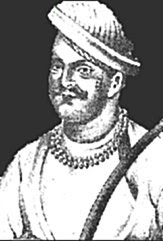
Tantya Tope (1814 - 1859)(pronounced Toh-pey), also known as Ram Chandra Pandurang, was an Indian leader in the Indian rebellion of 1857.
Born in at village Yeola in Maharashtra, he was the son of Pandurang Rao Tope, an important noble at the court of the Maratha Peshwa Baji Rao II. His father shifted his family with the ill-fated Peshwa to Bithur where his son became the most intimate friend of the Peshwa's adopted son, Nana Dhondu Pant (known as Nana Sahib) and Maharaja Madhav Singhji.
In 1851, when Lord Dalhousie deprived Nana Sahib of his father's pension, Tantya Tope also became a sworn enemy of the British. In May 1857, when the political storm was gaining momentum, he won over the Indian troops of the East India Company, stationed at Kanpur (Cawnpore), established Nana Sahib's authority and became the Commander-in-Chief of his forces.
After the reoccupation of Kanpur and separation from Nana Sahib, Tantya Tope shifted his headquarters to Kalpi to join hands with the Rani Lakshmi Bai and led a revolt in Bundelkhand. He was routed at Betwa, Koonch, and Kalpi, but reached Gwalior and declared Nana Sahib as Peshwa with the support of the Gwalior contingent. Before he could consolidate his position he was defeated by Hugh Henry Rose, 1st Baron Strathnairn in a memorable battle in which Rani Lakshmi Bai was killed leading her forces against the British assault on Gwailor.
After losing Gwalior to the British, he launched a successful guerrilla campaign in the Sagar and Narmada regions and in Khandesh and Rajasthan. The British forces failed to subdue him for over a year. He was, however, betrayed into the hands of the British by his trusted friend Man Singh, Chief of Narwar, while asleep in his camp in the Paron forest. He was captured and taken to Shivpuri where he was tried by a military court and executed at the gallows on April 18, 1859. There is a statue of Tantya Tope at the site of his execution near present collectorate in Shivpuri town in Madhya Pradesh.
****
Wednesday, March 12, 2008
Mohandas Gandhi: Biography
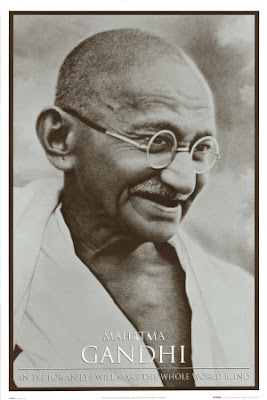 In South Africa
In South AfricaEducated in India and in London, he was admitted to the English bar in 1889 and practiced law unsuccessfully in India for two years. In 1893 he went to South Africa, where he was later joined by his wife and children. There he became a successful lawyer and leader of the Indian community and involved himself in the fight to end discrimination against the country's Indian minority. In South Africa he read widely, drawing inspiration from such sources as the Bhagavad-Gita, John Ruskin, Leo Tolstoy, Ralph Waldo Emerson, and Henry David Thoreau, and his personal philosophy underwent significant changes. He abandoned (c.1905) Western ways and thereafter lived abstemiously (including celibacy); this became symbolized in his eschewal of material possessions and his dress of loincloth and shawl. While in South Africa he organized (1907) his first satyagraha [holding to the truth], a campaign of civil disobedience expressed in nonviolent resistance to what he regarded as unjust laws. So successful were his activities that he secured (1914) an agreement from the South African government that promised the alleviation of anti-Indian discrimination.
Return to India
He returned (1915) to India with a stature equal to that of the nationalist leaders Gopal Krishna Gokhale and Bal Gangadhar Tilak. Gandhi actively supported the British in World War I in the hope of hastening India's freedom, but he also led agrarian and labor reform demonstrations that embarrassed the British. The Amritsar massacre of 1919 stirred Indian nationalist consciousness, and Gandhi organized several satyagraha campaigns. He discontinued them when, against his wishes, violent disorder ensued.
His program included a free, united India; the revival of cottage industries, especially of spinning and the production of handwoven cloth (khaddar); and the abolition of untouchability (see caste). These ideas were widely and vigorously espoused, although they also met considerable opposition from some Indians. The title Mahatma [great soul] reflected personal prestige so high that he could unify the diverse elements of the organization of the nationalist movement, the Indian National Congress, which he dominated from the early 1920s.
In 1930, in protest against the government's salt tax, he led the famous 200-mi (320-km) march to extract salt from the sea. For this he was imprisoned but was released in 1931 to attend the London Round Table Conference on India as the sole representative of the Indian National Congress. When the Congress refused to embrace his program in its entirety, Gandhi withdrew (1934), but his influence was such that Jawaharlal Nehru, his protégé, was named leader of the organization.
Indian Independence
In 1942, after rejection of his offer to cooperate with Great Britain in World War II if the British would grant immediate independence to India, Gandhi called for satyagraha and launched the Quit India movement. He was then interned until 1944. Gandhi was a major figure in the postwar conferences with the viceroy, Lord Mountbatten, and Muslim League leader Muhammad Ali Jinnah that led to India's independence and the carving out of a separate Muslim state (Pakistan), although Gandhi vigorously opposed the partition.
When violence broke out between Hindus and Muslims, Gandhi resorted to fasts and tours of disturbed areas to check it. On Jan. 30, 1948, while holding a prayer and pacification meeting at New Delhi, he was fatally shot by a Hindu fanatic who was angered by Gandhi's solicitude for the Muslims. After his death his methods of nonviolent civil disobedience were adopted by protagonists of civil rights in the United States and by many protest movements throughout the world.
Bibliography
See his autobiography (tr. 1927, repr. 1966); his collected works (50 vol., 1958–72); selected writings, ed. by R. Duncan (1972); R. N. Iyer, ed., The Moral and Political Writings of Mahatma Gandhi (3 vol., 1986–87) and The Essential Writings of Mahatma Gandhi (1991) ; biographies by D. G. Tendulkar (8 vol., 1951–54), B. R. Nanda (1958, repr. 1989), L. Fisher (1959), G. Ashe (1969), and S. Wolpert (2001); studies by J. V. Bondurant (rev. ed. 1965), E. Erikson (1969), and J. M. Brown (1972).
*****
Shaheed Bhagatsingh
 At the age of 23, if anyone was smiling just before he was being hanged to death, it was Shaheed Bhagat Singh. He was born September 27, 1907 in the village Banga of Layalpur to Mata Vidyavati and Sardar Kishan Singh. His uncle, Sardar Ajit Singh, as well as his father, were great freedom fighters, so Bhagat Singh grew up in a patriotic atmosphere. Ajit Singh established the Indian Patriots' Association, along with Syed Haidar Raza, to organize the peasants against the Chenab Canal Colony Bill. He also established the secret organization, the Bharat Mata Society. At an early age, Bhagat Singh started dreaming of uprooting the British empire. Never afraid of fighting during his childhood, he thought of "growing guns in the fields," so that he could fight against the British. The Ghadar Movement left a deep imprint on his mind. Kartar Sing Sarabha, hanged at the age of 19, became his hero. The massacre at Jallianwala Bagh on April 13, 1919 drove him to go to Amritsar, where he kissed the earth sanctified by the martyrs' blood and brought back home a little of the soaked soil. He studied in the D.A.V. School in Lahore. At the age of 16, he used to wonder why so many Indians could not drive away these fistful of invaders.
At the age of 23, if anyone was smiling just before he was being hanged to death, it was Shaheed Bhagat Singh. He was born September 27, 1907 in the village Banga of Layalpur to Mata Vidyavati and Sardar Kishan Singh. His uncle, Sardar Ajit Singh, as well as his father, were great freedom fighters, so Bhagat Singh grew up in a patriotic atmosphere. Ajit Singh established the Indian Patriots' Association, along with Syed Haidar Raza, to organize the peasants against the Chenab Canal Colony Bill. He also established the secret organization, the Bharat Mata Society. At an early age, Bhagat Singh started dreaming of uprooting the British empire. Never afraid of fighting during his childhood, he thought of "growing guns in the fields," so that he could fight against the British. The Ghadar Movement left a deep imprint on his mind. Kartar Sing Sarabha, hanged at the age of 19, became his hero. The massacre at Jallianwala Bagh on April 13, 1919 drove him to go to Amritsar, where he kissed the earth sanctified by the martyrs' blood and brought back home a little of the soaked soil. He studied in the D.A.V. School in Lahore. At the age of 16, he used to wonder why so many Indians could not drive away these fistful of invaders.
In search of revolutionary groups and ideas, he met Sukhdev and Rajguru. Bhagat Singh, along with the help of Chandrashekhar Azad, formed the Hindustan Socialist Republican Army (HSRA). The aim of this Indian revolutionary movement was now defined as not only to make India independent, but also to create "a socialist India."
During the Simon Commission, Sher-e-Punjab Lala Lajpat Rai was wounded and died later. To avenge his death, Bhagat Singh and Rajguru killed Mr. Saunders (one of the deputy officers in connection with the Simon Commission).
When the British government promulgated the two bills "Trade Union Dispute Bill" and "Public Safety Bill" which Bhagat Singh and his party thought were Black Laws aimed at curbing citizens' freedom and civil liberties, they decided to oppose these bills by throwing a bomb in the Central Assembly Hall (which is now Lok Sabha). However, things changed, and the Britishers arrested Bhagat Singh and his friends on April 8, 1929.
He and his friends wanted to be shot dead, since they were termed as prisoners of war. Their request was not fulfilled, and on March 23, 1931, Bhagat Singh, Shivram Rajguru, and Sukhdev were hanged to death.
This man's only mission in life was to see his country free from British rule. He did his best and when he was being led to the gallows, he was satisfied that he had lived up to his principles, irrespective of the consequences. The only thing that made him sad was that he couldn't do more for his country.
Chandrashekhar Azad
 Chandra Shekhar was born on 23 July 1906 to Pandit Sita Ram Tiwari and Jagrani Devi. He received his early schooling in Bhavra. For higher studies he went to the Sanskrit Pathashala at Varanasi.
Chandra Shekhar was born on 23 July 1906 to Pandit Sita Ram Tiwari and Jagrani Devi. He received his early schooling in Bhavra. For higher studies he went to the Sanskrit Pathashala at Varanasi.
Young Chandra Shekhar was fascinated by and drawn to the great national upsurge of the non-violent, non-cooperation movement of 1920-21 under the leadership of Mahatma Gandhi. When arrested and produced before the magistrate, he gave his name as 'Azad', his father's name as 'Swatantra' and his residence as 'prison'. The provoked magistrate sentenced him to fifteen lashes of flogging. The title of Azad stuck thereafter.
After withdrawal of the non-cooperation movement, Azad was attracted towards revolutionary activities. He joined the Hindustan Socialist Republican Army (HSRA) and was involved in the Kakori Conspiracy (1926), the attempt to blow up the Viceroy's train (1926), the Assembly bomb incident, the Delhi Conspiracy, the shooting of Saunders at Lahore (1928) and the Second Lahore conspiracy.
Azad was on the wanted list of the police. On 27February 1931, in the Alfred Park, Allahabad, when an associate betrayed him, well-armed police circled Azad. For quite sometime he held them at bay, single-handedly with a small pistol and few cartridges. Left with only one bullet, he fired it at his own temple and lived up to his resolve that he would never be arrested and dragged to gallows to be hanged. He used to fondly recite a Hindustani couplet, his only poetic composition:
'Dushman ki goliyon ka hum samna karenge,
Azad hee rahein hain, azad hee rahenge'
Chandrashekhar Azad (1906 -1931)
Betrayed by an informer on 27 February 1931 Azad was encircled by British troops in the Alfred park, Allahabad.
He kept on fighting till the last bullet.Finding no other alternative, except surrender,Chandrashekar Azad shot himself
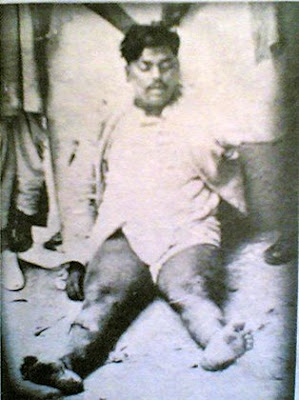
Chandrashekar Azad's dead body kept on public display by the British to serve as a warning message for other revolutionaries.
****
Shahid-e-Azam Bhagat Singh
Bhagat Singh points out in his article "Why I am an Atheist" that it is not easy to live the life of a reasoning person. It is easy to take consolation or relief from blind faith. But it is our duty to try ceaselessly to live the life of reason. And that is why Bhagat Singh asserts at the end of the essay that by proclaiming himself an athiest and a realist (materialist) he was "trying to stand like a man with an erect head to the last; even on the gallows".
Bhagat Singh was not the first of the many young Indians who sacrificed their lives at the altar of Indian freedom; others too kissed the noose and embraced the gallows with a defiant cry of Inkalab Zindabad! on their lips. We revere the memory of each one of these martyrs. Bhagat Singh should primarily be studied as a political figure. It should be noted that as early as the beginning of 1928, when he was just entering his twenties, he and his comrade, Bhagwati Charan Vohra, very correctly visualised the future course of political development in India-some sort of Round Table Conference; a compromise between the British and the Congress leaders; a gradual merging of a section of Indian capital with British capital, the congress leadership becoming the spokesmen for this section of capitalists; They also asserted that some of the then champions of the freedom strugglewould, in due course, become the champions of Indo- British 'cooperation' and betray the cause of national freedom. After that, they said, task of leading and carrying forward the freedom struggle would fall to the workers and peasants, to the common people, led by the proletariat and a party based on the messes and relying on the teaching of Marx. All these points amply emerge from the letters and documents written by Bhagat Singh and especially from the Manifesto of the Naujwan Bhagat Sabha which was drafted mainly by him and Bhagwati Charan.
It is in this that Bhagat Singh differed from the earlier revolutionary martyrs; it is in this that he rose higher than many of the political leaders of his time and in this lay his greatness. It is true that Bhagat Singh was not a Marxist in the full sense of the term. But it is also true that he had come very near Marxism towards the end of his days. In one of his letters to Sukh Dev, he wrote: " You and I may not live but our people will survive. The cause of Marxism and Communism is sure to win." Bhagat Singh was link between the Revolutionaries of the past and the communist movement of today. This is the perspective of this short study
***
FOOT PRINTS OF THE LIFE
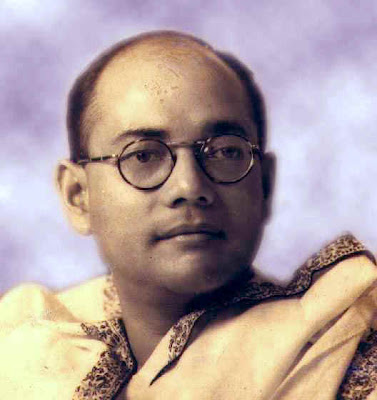
In January Subhash Chandra was prisoned for one year, and again in 1931. From January 1932 to March 1933 he was in detention without trial. He became ill and went to Vienna. In 1934 he wrote 'The Indian Struggle'. He arrived Mumbai in April 1936, from Vienna, and was arrested further.
Despite of all opposition from the Rightists, Subhash Chandra was elected Congress President in 1938, and re-elected in 1939 by defeating Gandhi's own nominee. When in his Presidential address at Haripura in 1938 he had drawn the outline for developing an Independent India of the future through a completely socio-economic planning, then in his address at Tripura Session in 1939 made the historic proposal that the Congress should give an ultimatum to the British Government demanding independence within six months and should simultaneously prepare for the final battle for freedom. But his proposal was bitterly opposed by the Rightists who were inclined to take the path of collaboration with the ruling power. He was curbed with all his powers, was imposed by so many terms and conditions that his positional authority became collapsed. It was the period when confrontation between Subhash Chandra and Gandhi rose to the highest level, and in consequence, Subhash Chandra resigned from Congress Presidentship on 29 April 1939. But he continued his own course of action. In retaliation, Bengal Provincial Congress Committee headed by him was suspended by the Congress High-command, and he was expelled from the party. But his approach, his arguments, and mass support towards his stand remained unabated.
Subhash Chandra announced the Formation of Forward Bloc at a public meeting in Calcutta on 3 May 1939. And then it became imminent to constitute Forward Bloc with a definite process, and on 22 June 1939 First All India Session of Forward Bloc held in Mumbai.
The prime contradiction between two powers, Subhash and Gandhites, between Leftists and the Rightists, at that time, was basically a contradiction between compromise and anti-compromise, between constitutionalism and revolutionary means. And thus, Subhash Chandra Bose, his image, became the symbol of revolutionary leftism in India. In March 1940 there was held a Congress Session at Ramgarh of Bihar. Subhash Chandra, on the same date and venue convened a parallel anti-compromise conference, which challenged Congress leadership about their sincerity towards the people of the country and their integrity for achieving unconditional independence, The conference completely washed away the Congress Session. Subhash Chandra, through this Anti-compromise Conference, practically, tied the workers and peasants of the country with one single equation and made a platform to combat the right-wing and reactionery forces. To consolidate the countrywide movement through a party discipline the First All India Conference of All India Forward Bloc was held in Nagpur, from 18 to 22 June, 1940, under his Presidentship. Here Forward Bloc was declared as a Socialist party.
Friday, March 7, 2008
Quite a Memorable Year for Indian Community
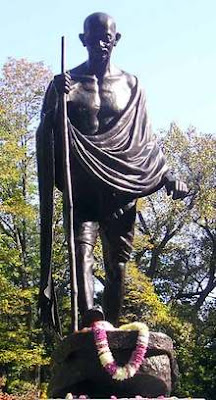 It has been quite an exhilerating ride for the Indian community in Cleveland. In October, a magnificent statue of Mahatma Gandhi was dedicated at the India Cultural Garden in Rockefeller Park. Considering the influence of Mahatma Gandhi on Dr. Martin Luther King, Jr. and the civil rights movement, it is interesting that the statue is located off Martin Luther King Boulevard.
It has been quite an exhilerating ride for the Indian community in Cleveland. In October, a magnificent statue of Mahatma Gandhi was dedicated at the India Cultural Garden in Rockefeller Park. Considering the influence of Mahatma Gandhi on Dr. Martin Luther King, Jr. and the civil rights movement, it is interesting that the statue is located off Martin Luther King Boulevard.
The 10-ft bronze statue, by world famous sculptor Gautam Pal of Kolkatta (formerly known as Calcutta) is the first Gandhi statue in Ohio. Mr. Ronen Sen, India's ambassador to the U.S., Rev. Dr. Otis Moss, Jr, pastor of the Olivet Institutional Baptist Church, U.S. Congressman Dennis Kucinich and Cleveland City Council Majority Leader Sabra Pierce Scott unveiled the statue, capping an emotional day for the Indian community.
The dedication was held as part of One World Day, the annual celebration of Cleveland's ethnic diversity. The India garden hosted the event to highlight the significance of adding Mahatma Gandhi, the icon of peace to the landscape of the Cleveland Cultural Gardens, whose motto is: "Peace Through Mutual Understanding".
Earlier in the day, soil from India was added to a crypt at the American Legion garden that contains soil from the other countries represented in the Cleveland Cultural Gardens. This was the first time the ceremony, symbolic of the unity of cultures, had been performed in almost 50 years. Soil from the Gandhi Museum in Madurai, and the Gandhi Ashram in Sabarmati, India had been brought to Cleveland for the ceremony, which was conducted by Ambassador Ronen Sen.
In December, Indian born entreprenuer Monte Ahuja, Chairman and CEO of Transtar Industries and his wife, Usha Ahuja announced a $30 million gift to University Hospitals of Cleveland, the largest single gift in the hospital's 140-year history. In recognition of the gift, the soon to be built 200 bed hospital in Beachwood will be named the Ahuja Medical Center. The Ahujas are major supporters of the Indian community-- Mr. Ahuja is a past president of the Federation of India Community Associations, better known as FICA, and Mrs. Ahuja served as the Chair of the Board of Trustees.
Later in December, Dr. Mohan Reddy, Professor of Technology Management at Case Western Reserve University's Weatherhead School of Management, was appointed as the Dean of the school. He had been serving as the interim dean since August. Dr. Reddy, a graduate of the University of Mysore, India joined CWRU in 1985, and has been the recipient of multiple teaching excellence awards. He also serves as a director of several local companies.
Highlighting the contributions of the large number of Indian physicians in the Cleveland area, Dr. Arun Singh, director of Ophthalmic Oncology at the Cole Eye Institute at the Cleveland Clinic was appointed as the editor of the British Journal of Ophthalmology, an international peer-reviewed publication for clinical and laboratory investigations. Dr. Singh received his medical degree from Jawaharlal Institute of Post Graduate Medical Education and Research in Pondicherry, India.
The pride of the community was evident at the annual celebration of India's Republic Day, which attracted a large number of attendees on a cold, snowy night in January. Former Congressman Louis Stokes, who was the featured speaker, spoke of the progress that India has made in recent years and the buzz that it has created. To those in attendance, the momentum of the past few months was unmistakable....
Mahatma Gandhi on list of 100 greatest South Africans
Mahatma Gandhi on list of 100 greatest South Africans
Mahatma Gandhi is up against a pioneering surgeon, a golfer, a cleric and President Thabo Mbeki on a shortlist of nine people to find the second greatest South African of all time.
Former president Nelson Mandela was voted the top man by an overwhelming margin when the list of the greatest 100 South Africans was announced by the South African Broadcasting Corporation's SABC3 channel on Sunday.
Mohandas Karamchand Gandhi, the lawyer who was destined to become the Mahatma, was the only nominee in the top 100 who was not born in South Africa.
The role that Gandhi played in the freedom struggle in South Africa was highlighted by his selection as a finalist in the top ten. He also got more votes than other great South African leaders and contemporaries of Mandela like Walter Sisulu and Nobel Peace Prize laureate Chief Albert Luthuli.
The other contenders are: Winnie Madikizela-Mandela, former wife of Nelson Mandela; former state president FW de Klerk; golfing legend Gary Player; former Archbishop Desmond Tutu and deceased nominees Chris Barnard, who performed the world's first heart transplant, Xolani Nkosi Johnson, a young lad who won millions of hearts with his public appearances speaking about fighting HIV/AIDS before succumbing to it and former prime minister Jan Smuts.
